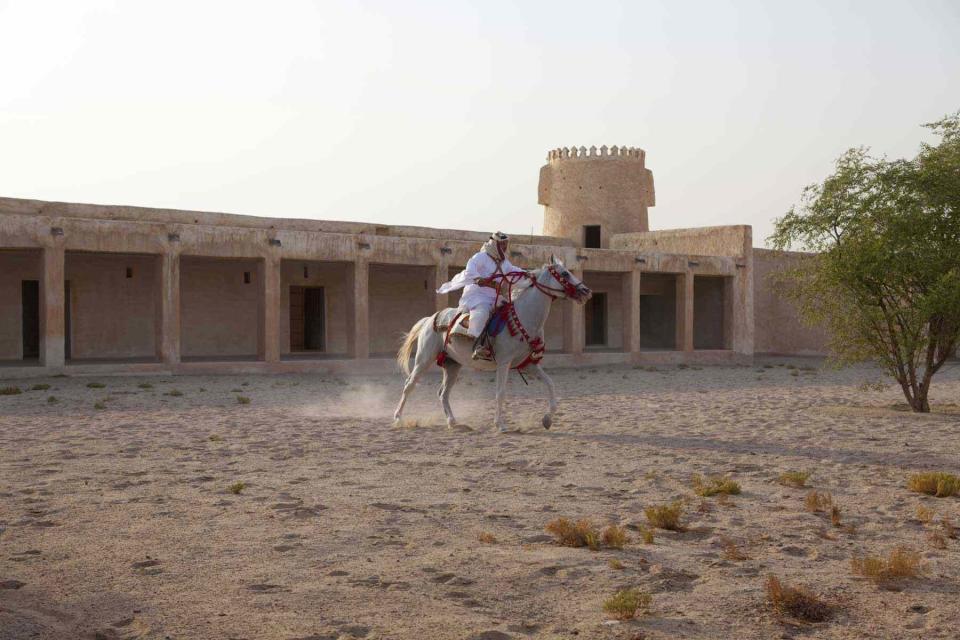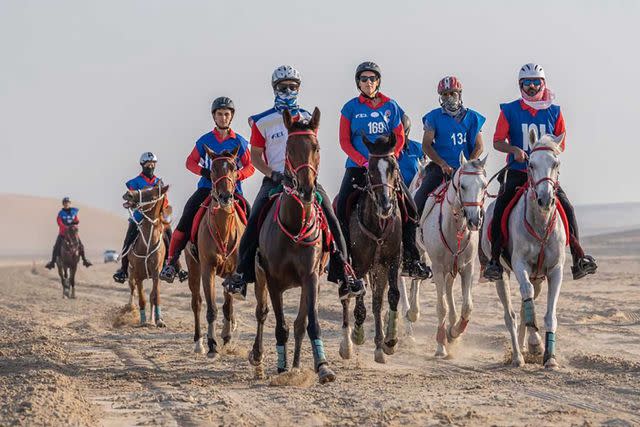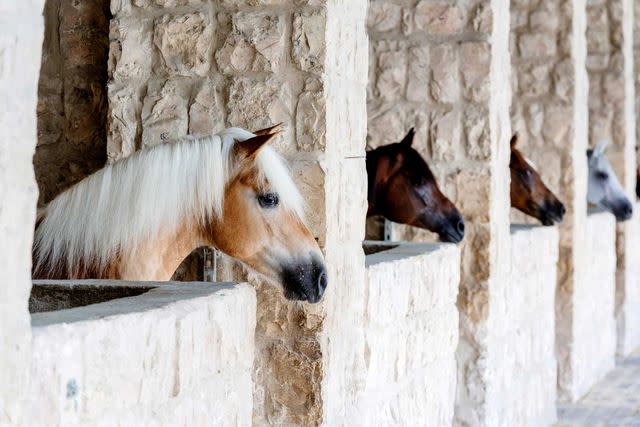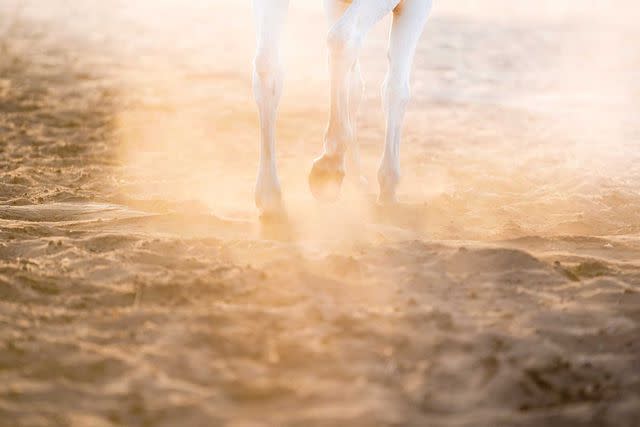In Qatar, Famous Racehorses Are Treated Like Royalty — With Saunas, Lap Pools, and Luxurious Training Facilities
In the desert outside Doha, one writer gets carried away by the allure of these purebred endurance racers.

ANDRE SHIWA/COURTESY OF AL SHAQAB
The old fort at Al Shaqab, an Arabian training facility in Ar Rayyān, Qatar.I was an hour outside Doha when my Uber dropped me at the unmarked gates of Khor Aladed Riding School. The modest stable sits smack in the middle of the Mesaieed Desert, where the sand seems to stretch endlessly into the horizon and blurs into a whitish haze. Before he pulled away, the driver told me to WhatsApp him when I was ready to be picked up. “Otherwise, nobody will find you out here,” he warned.
Khor Aladed is home to 20 purebred Arabian endurance racers, finely tuned horses as synonymous with the desert as the rolling dunes. Bedouins — the nomadic people who live in the region — began breeding the first Arabians more than 4,500 years ago, and their incredible stamina (not to mention exquisite bone structure) made them legendary across the Arabian Peninsula. No other animal is as well suited to racing across miles and miles of desert.
Beyond the gates of the school, Elena Gonzalez, a 28-year-old endurance rider from Asturias, Spain, greeted me in a small courtyard where six Arabians were waiting to be harnessed. The animals were trim, compact, and, despite the shamal — the gusts of wind blowing up sand that afternoon — surprisingly calm. This was due to the level of familiarity they have with Gonzalez, who averages eight hours in the saddle during a race. Prolonged contact with the animal is what first drew her to the sport. “Endurance is more intimate than show jumping or dressage,” Gonzalez said, wrapping her arms around Aneesah, a snow-colored mare with a silky, windblown mane. “You get to know the horse more deeply.”

Courtesy of Khor Aladed
Khor Aladed’s endurance racing team is used to riding for hours on end.The strain of endurance racing can’t be overstated. Earlier in the week, I booked an hour-long riding lesson at Al Samriya, a private ranch 30 minutes from the city center. No Arabians were available, so I was paired with a Dutch warmblood named Alvaro, who must have sensed my unease. I used to ride as a kid, but that was 25 years ago, and the movements no longer felt intuitive. My feet fumbled in the stirrups when Alvaro picked up to a trot, and I recalled the sheer leg power required just to stay upright. How did Gonzalez muster this strength for an entire day?
Then again, I hadn’t come here to test my riding skills. What interested me more was the mythology of Arabians, which are treated as symbols of Qatari heritage, like flamenco music in Spain or roses in England. They inspire pride among locals, particularly the royal family, the Al Thanis, who assert that when it comes to producing show-quality Arabians, no other nation can touch theirs. Often, they’re right: in 2011 and 2014, the International Equestrian Federation ranked Faleh Bughanaim, a Qatari, the best rider in the world. At Paris’s 1.5-mile Prix de l’Arc de Triomphe — widely considered the most prestigious race in the world — Qatar has won gold several times. The country has claimed 10 world-champion stallion trophies over the past 20 years at the Salon du Cheval in Paris; seven of those wins came from a single equestrian center: Al Shaqab.
Earlier in the week, I had visited Al Shaqab, in Ar Rayyān, just outside Doha. The immaculate, horseshoe-shaped campus is like a cross between Versailles and a luxury mall, its tree-lined avenues leading to an immense indoor arena with multiple cafés and glass-enclosed suites (the best seats are reserved for the royal family). The facilities also include a four-star hotel (for humans), a hospital (for horses), and multiple training sites (for both). Visitors can sign up for riding lessons and boast that they trotted next to champion Arabians.

DAVID BERRIDGE/COURTESY OF AL SAMRIYA
The stables at Al Samriya.Being a horse at Al Shaqab certainly has its perks. Inside the hangar-like building that houses the equine exercise center, I watched a chestnut stallion paddle the length of an inviting lap pool, while another kept pace on a treadmill fitted with metallic on- and off-ramps. Nearby, there was a walking carousel, a Jacuzzi, and a sauna with heat lamps. The equipment at my hotel gym wasn’t this state-of-the-art; then again, I didn’t have an entire nation pinning its hopes on my ability to speed along a dirt track.
If the stakes seem high for these horses to succeed, it’s because they are. Al Shaqab’s goal is not only to produce Arabians that dominate international competitions but also — through educational programs and historical exhibits — to make good on Qatar’s promise to change from an oil-and-gas economy into a “knowledge-based economy” by 2030. That’s a tall order, but from a rider’s perspective, the potential for prestige (and cash) is huge. At CHI, a three-day tournament hosted at Al Shaqab in February, the prize money added up to nearly a million dollars.
Back at Khor Aladed, a stable worker was rubbing oil on the hooves of a stallion with caramel and white markings. In a small building adorned with photographs of past tournaments, I shared cardamom-infused, milky karak tea — robust, rich, and flavorful, like Indian masala chai — with head trainer Sarea Al Shahwani, who opened the school in 2014. Since then, Khor Aladed has emerged as a major player in Qatar’s endurance-racing scene (when I asked Al Shahwani how many races he’s won, he told me he had lost count). The riders saddled up, and Al Shahwani invited me into his Land Cruiser to trail the team as they rode off into the desert.

MOHAMED TINAKICHT/COURTESY OF AL SHAQAB
Hooves kick up dust at Al Shaqab.After a few miles, we came to an oval track the size of a football field. There was no signpost or tarmac: just flat, endless sand. The horses broke into a lively canter, stirring up small clouds of dust and devouring the empty expanse. I was struck by the effortlessness of their movements. Despite the shifting terrain, the creatures were so graceful their hooves seemed to barely touch the ground.
Al Shahwani leaned over, taking a break from shouting instructions at the riders. “In the Quran,” he explained, “there is a verse saying that horses were made from the wind.” The riders continued looping around the track without pause, and I watched the sun fade to a pale gold disk over the dunes. By the end of the session, the riders were beaming, but spent. The horses hadn’t broken a sweat.
A version of this story first appeared in the November 2022 issue of Travel + Leisure under the headline "Riders of Arabia."
For more Travel & Leisure news, make sure to sign up for our newsletter!
Read the original article on Travel & Leisure.

